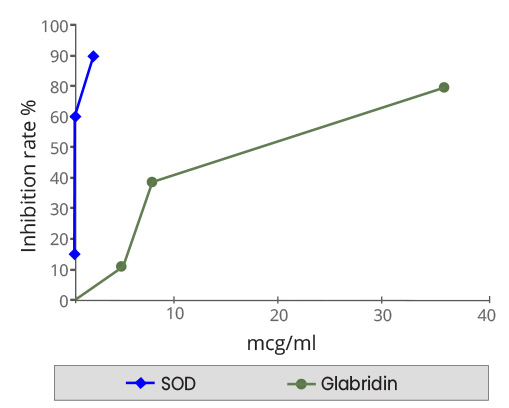Glabridin may inhibit melanogenesis by one of two mechanisms:
- Inhibition of the production of reactive oxygen species: (02)
- Inhibition of tyrosine: Human tyrosinase is an essential enzyme, which regulates the production of melanin, a group of brown to black pigments in the skin and eyes of humans.
It is a known fact that a number of reactions (e.g. inflammatory, etc.) are induced when human skin is exposed to UV radiation. The membrane phospholipids of the skin tissue are damaged by UV-induced active oxygen. Histological changes occur in the skin that manifest as erythemas and skin pigmentation. Active oxygen is one of the species that induces skin pigmentation. Thus, prevention of its production is linked to inhibition of melanogenesis. To test this, an assay was performed to study the inhibitory effect of glabridin on superoxide anion production. As shown in Figure, glabridin inhibited superoxide (active oxygen) formation at concentrations from 0.33 µg/ml to 33.3 µg/ml.

Thus, licorice may be useful for treating conditions like melasma or pigmentation of skin due to sun-exposure.
In a comprehensive study carried out by Yokota, T. et al. , the inhibitory effects of glabridin on melanogenesis as well as inflammation were examined. The structure-function relationship of glabridin was also studied. Topical skin-depigmentation activities of the active component, glabridin, were examined using UVB-induced pigmented skins of brownish guinea pigs. A 0.5% glabridin solution was applied topically to the skin. Topical application of glabridin significantly reduced pigmentation induced by UVB radiation on the backs of the brownish guinea pigs. Skin samples were also taken from each of the glabridin treated areas for histological studies. The treated tissue was stained with 0.1% DOPA and the inhibition of melanogenesis was evaluated by counting the number of DOPA-positive melanocytes/mm2 under an optical microscope. Epidermal histological studies performed showed that DOPA-positive melanocytes reduced in number on the skin treated with glabridin. Treatment with glabridin also lightened the skin color due to inhibition of melanogenesis. The authors concluded that the glabridin present in Licorice roots inhibits both melanin synthesis and inflammation. They also observed that these properties of glabridin were related to its structure.
